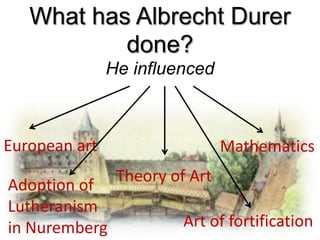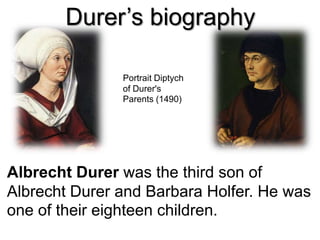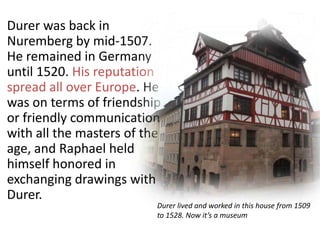Albrecht Durer
- 1. Albrecht Durer the man who modernized arts
- 2. Who is Albrecht Durer? Albrecht Durer is the greatest exponent of Northern European Renaissance art. While an important painter, in his own day Durer was renowned foremost for his graphic works. Artists across Europe admired and copied Durer's innovative and powerful prints, ranging from religious and mythological scenes, to maps and exotic animals. Durer was a humanist and a creator. His awareness of his own role as an artist is apparent in his frontal, Christ-like Self Portrait, 1500, just one of many self portraits that he painted in his career. More than simply producing works for his own time, Durer saw his fame and his contribution as enduring, and as part of history.
- 3. What has Albrecht Durer done? He influenced European art Theory of Art Mathematics Art of fortification Adoption of Lutheranism in Nuremberg
- 4. Durer’s biography Albrecht Durer was the third son of Albrecht Durer and Barbara Holfer. He was one of their eighteen children. Portrait Diptych of Durer's Parents (1490)
- 5. Albrecht Durer was born on May 21st 1471 in Imperial Free City of Nuremberg. At the age of fifteen Durer was apprenticed to the principal painter of the town, Michael Wolgemut, a prolific if undistinguished producer of small works in the late Gothic style. Durer learned not only painting but also wood carving and elementary copper engraving under Wolgemut. At the end of his apprenticeship in 1490 he travelled (Wanderjahre). He practiced in Colmar, Basel and in the Low Countries (Holland) before he returned to Nuremberg. From this period, little of the work that can be attributed to him with certainty survives. Portrait of the Artist Holding a Thistle (1493)
- 6. On July 9, 1494 Durer was married, according to an arrangement made during his absence, to Agnes Frey, the daughter of a local merchant. His relationship with his wife is unclear and her reputation has suffered from a posthumous assault by Durer's friends. He did not remain in Nuremberg long; in the autumn of 1494 he travelled to Italy, Agnes Durer (1494)
- 7. More than any other Northern European artist, Durer was engaged by the artistic practices and theoretical interests of Italy. He visited the country twice, from 1494 to 1495 and again from 1505 to 1507, absorbing firsthand some of the great works of the Italian Renaissance, as well as the classical heritage and theoretical writings of the region. The influence of Venetian color and design can be seen in the Feast of
- 8. Durer was back in Nuremberg by mid-1507. He remained in Germany until 1520. His reputation spread all over Europe. He was on terms of friendship or friendly communication with all the masters of the age, and Raphael held himself honored in exchanging drawings with Durer. Durer lived and worked in this house from 1509 to 1528. Now it’s a museum
- 9. Durer's talent, ambition, and sharp, wide-ranging intellect earned him the attention and friendship of some of the most prominent figures in German society. He became official court artist to Holy Roman Emperors Maximilian I and his successor Charles V, for whom Durer designed and helped execute a range Emperor Maximilian (1518)
- 10. After another journey to the Netherlands Durer finally returned home in July 1521, having caught an undetermined illness which afflicted him for the rest of his life. Back in Nuremberg he began work on a series of religious pictures. Many preliminary sketches and studies survive, but no paintings on the grand scale were ever carried out. This was due in part to his declining health, but more because of the time he gave to the preparation of his theoretical works on geometry and perspective, proportion and fortification.
- 11. Durer’s influence on the European artDurer developed a new interest in the human form, as demonstrated by his nude and antique studies. He was also one of the first artists to depict animals “photorealistically”. “As I grew older, I realized that it was much better to insist on the genuine forms of nature, for simplicity is the greatest adornment of art” Albrecht Durer
- 12. Durer’s influence on theory of art He wrote Four Books of Human Proportion (Vier Bücher von menschlichen Proportion), only the first of which was published during his lifetime (1528), as well as an introductory manual of geometric theory for students (Underweysung der Messung, 1525), which includes the first scientific treatment of perspective by a Northern European artist.
- 13. Durer’s influence on mathematicsDescriptive geometry originated with Durer in his introductory manual of geometric theory for students although it was only put on a sound mathematical basis in later works of mathematicians. One of the methods of overcoming the problems of projection, and describing the movement of bodies in space, is descriptive geometry. Durer's remarkable achievement was through applying mathematics to art, he developed such fundamentally new and important ideas within mathematics itself.
- 14. Durer’s influence on the art of fortification In 1527 Durer published another work, this time on fortifications. There were strong reasons why he produced a work on fortifications at this time, for the people of Germany were in fear of an invasion by the Turks. Many cities, including Nuremberg, would improve their fortifications using the methods set out by Durer in this book.
- 15. Durer’s influence on the adoption of Lutheranism in Nuremberg In Nuremberg, a vibrant center of humanism and one of the first to officially embrace the principles of the Reformation, Durer had access to some of Europe's outstanding theologians and scholars, including Erasmus, Philipp Melanchthon, and Willibald Pirkheimer, each captured by the artist in shrewd portraits. For Nuremberg's town hall, the artist painted two panels of the Four Apostles (1526), bearing texts in Martin Luther's translation that pay tribute to the city's adoption of Lutheranism.
- 16. Durer’s art is so multifarious! Explore it!
- 17. This all is DURER
- 18. Resources used • http://www.albrecht-durer.org/biography.html • http://www.metmuseum.org/toah/hd/durr/hd_durr.htm • http://www-groups.dcs.st-and.ac.uk/~history/Biographies/Durer.html • http://www.artcyclopedia.com/artists/durer_albrecht.html • http://www.brainyquote.com/quotes/authors/a/albrecht_durer.html • http://meganandvince.blogspot.ru/2011/03/nuremberg-bavarian- secret-to-pass-on.html

















